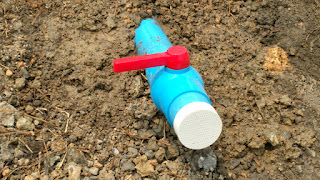After digging the trench and laying the overflow pipe, I thought it was just a simple matter of filling in the trench. But, as I’ve noticed with the software development projects at work, sometimes workers get distracted by other projects. Something that is 99% complete can sit unfinished for a surprising amount of time. Apparently, a good chunk of my role is in reminding managers that after the team of workers invested several hours in something, they still must be nudged to spend the last 10 minutes to complete it. This is a bit understandable though. Something else that is urgent comes up, and then something else. And before long finishing this project just kinda gets forgotten.
Note to anyone that has a job, particularly if that job is at our company: developing the ability to go back and finish projects even when other things are vying for your attention without needing another manager looking over your shoulder to make sure you finish is a good way to get promotions and make more money. At least it is where I work. And it applies to all of the construction workers we’ve ever hired. If it doesn’t apply where you work, you might want to find another job. 😉
Initially, I was thinking I would add a mosquito net strainer to keep the little buggers from breeding in any water that happens to collect in the pipe. (As well as keeping snakes and other undesirable critters from nesting in there.) But as with many of the things I’ve needed recently, I decided to 3D print it. As a “cap”, I decided to try the flexible material for it.
I didn’t put in as many holes as I’d like due to some performance issues in FreeCAD. But here is how it turned out:
Water from a faucet goes straight through, so it should work fine. In fact, the pipe is much larger than it needs to be. I just couldn’t find a smaller ball valve to mount, so I needed to choose the larger PVC pipe to fit with the larger ball valve. And anyway, if I need one with more holes, I can always print it later.
Keep in mind that it only needs to drain as fast as the rains come. According to this page the maximum average monthly rainfall (September) is about 350mm. If we estimate that an unusually large rainfall day would be about 10x the average daily amount for September, this comes out to 10*350mm/30 = 117mm per day. This concerts to about 2.4 liters per second based on the size of the pond. And in a worst case scenario if the water doesn’t go out quickly enough, I can just pop off the cap and let the water rush out. (I don’t glue it on.)
So here it is installed and ready for the rains to come:
Yeah, I’m not a big fan of the red handle either. But it will probably fade in the sun after a few months.
In fact, I’ve been wondering how well the flex filament that I used to print the white strainer cap will handle the UV exposure of direct sunshine. I guess I’ll just have to wait and see. (The stormy season is about 6 months away, and I doubt the pond will fill up until next year’s rainy season anyway, so it will get quite a bit of sunlight before it really matters.)


